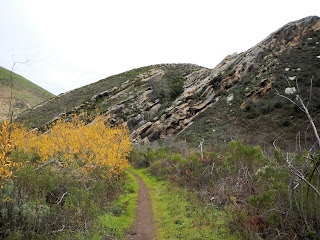Coon Creek Trail
Usnea growing on Oak tree
Usnea is an air plant that grows at the elevation where average morning coastal fog settles, and thus gathers its water. Usnea has an antibacterial quality and was used by the aboriginal peoples for diapering their infants, other sanitary applications, and as a packing material for their belongings.
Usnea
Another useful plant I found was Coffeeberry. This plant has small dark brown berries in the Spring and early Summer which have a flavor reminiscent of coffee. They have a laxative application and were used by the aboriginals to offset the constipating effects of a heavy acorn diet. In my experience, just a small handful will gently open the bowel in just a few hours.
Coffeeberry
Bracken fern grows along the trail in several places. My understanding is that a tea made from the roots can relieve stomach cramps and diarrhea, and can be applied as a poultice for burns & sores. I also have read the aboriginals used the roots for cordage and weaving baskets. Even when most other plants are dried out, Bracken ferns remain green because they have such deep roots and thus access deeper moist ground.
Bracken Fern
One animal that's presence is very much in evidence is the Dusky Footed Woods Rat, or Pack Rat. Actually just their dens, which are abundant in the woods alongside the trail.
Woods Rat den
I have never seen a "live" Woods Rat on the trail, but did come across a dead one once. They are quite large, about the size of a common Grey Squirrel, with a long slender tail. They were consumed by the aboriginal Californians as food. A hunter with a long pole would probe the nest and attempt to locate the rat. A notch was cut in the pole and a slight twist caused it to bind in the rat's fur and hold it. If the rat panicked and fled the nest, archers stationed around the nest would pick it off. It would then be thrown on a fire and cooked, fur, entrails, and all! The presence of fresh green vegetation fragments at the entrance holes indicates an active nest.
I reached the end of the trail, which is a grove of old trees. Here I stopped to make some coffee and something to eat.
Trails end
I used a Swiss M71 stove with BOILEX "ZIP" fuel, a product of the U.K. dating back to 1936, which I found at RITE AID in their sporting goods section. Using my STANLEY "Adventure Cookset", I achieved a boil of 1 pint of water in about 20 minutes.
Cookset and "ZIP" fuel
Afterwards, I observed that a fairly good piece of the fuel remained inside the stove, so it made a boil and had fuel leftover when I extinguished it. I enjoyed a hot cup of coffee and a meal of beef ramen with beef jerky mixed in.
Cooking some lunch [Video]
After my break I started walking back down the trail, looking for more resources as I went along. I saw these little plants growing and the leaves are like strawberry's, so they might be Wild Strawberry. Supposedly, a nice tea can be made from the leaves, but I am not certain that is what these are and will need to check further before attempting a brew.
Wild Strawberry?
Another plant I recognized was this narrow-leaf Plantain [below]. Plantain was a plant brought to America from Europe. The leaves can be made into a tea to treat cough and diarrhea. A poultice can be used for sores and insect stings. A few months ago I was working on a trail and dug up a Wasp or Hornet nest. One of them stung me on the head. I did not have my sting pen, so I plucked some Plantain leaves, chewed them into paste and plastered the paste onto the sting. I experienced instant cooling relief that was long lasting and allowed me to continue to work.
Narrow Leaf Plantain
A little further down the trail I began to see new Hummingbird Sage plants growing. This plant's leaves can be made into a tea that tastes nice and has a decongestant quality. Later in the Spring they will have a tall purplish flowered stalk protruding from their center.
Hummingbird Sage
When I say "Make a tea" generally, you need a good amount of leaves, like your hands cupped together, to 1 cup of water. Boil the water, remove from the fire, and then add the leaves and allow them to steep. More or less leaves can adjust the taste to your liking.
As I brought my hike to an end, I observed a Cotton-Tail Rabbit cross the trail and hop into some brush. Noting where he entered the brush, I observed just the slightest trail, somewhat bare from traffic and barely visible. Were someone to need food such as in a survival situation, this would be the place to rig a snare to catch a meal.
Rabbit run
My recce took about 4 hours total and was a wonderful day spent exploring the local woods and enjoying nature. If you have found this discussion of medicinal and edible plants useful, I would recommend that you seek professional plant identification instruction. Handbooks and guides are useful, but do not compare with hands-on learning. There are poisonous plants and some resemble "safe" plants and can harm you if ingested. Check with your Park Authority, the local Botanical Garden or Society, or local College for availability of plant identification courses. Never ingest a plant you are not absolutely certain of.
'Happy Hiking!
GOBLIN RANGER
[Bushcraft Woods Devil]

















